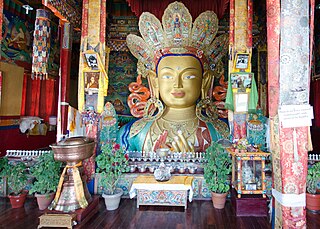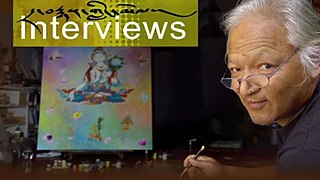
Malcolm A. Morley was a British-American visual artist and painter. He was known as an artist who pioneered in various styles, working as a photorealist and an expressionist, among many other genres. In 1984, he won the inaugural Turner Prize.

The vast majority of surviving Tibetan art created before the mid-20th century is religious, with the main forms being thangka, paintings on cloth, mostly in a technique described as gouache or distemper, Tibetan Buddhist wall paintings, and small statues in bronze, or large ones in clay, stucco or wood. They were commissioned by religious establishments or by pious individuals for use within the practice of Tibetan Buddhism and were manufactured in large workshops by monks and lay artists, who are mostly unknown. Various types of religious objects, such as the phurba or ritual dagger, are finely made and lavishly decorated. Secular objects, in particular jewellery and textiles, were also made, with Chinese influences strong in the latter.

Elaine Frances Sturtevant, also known professionally as Sturtevant, was an American artist. She achieved recognition for her carefully inexact repetitions of other artists' works.

A thangka is a Tibetan Buddhist painting on cotton, silk appliqué, usually depicting a Buddhist deity, scene, or mandala. Thangkas are traditionally kept unframed and rolled up when not on display, mounted on a textile backing somewhat in the style of Chinese scroll paintings, with a further silk cover on the front. So treated, thangkas can last a long time, but because of their delicate nature, they have to be kept in dry places where moisture will not affect the quality of the silk. Most thangkas are relatively small, comparable in size to a Western half-length portrait, but some are extremely large, several metres in each dimension; these were designed to be displayed, typically for very brief periods on a monastery wall, as part of religious festivals. Most thangkas were intended for personal meditation or instruction of monastic students. They often have elaborate compositions including many very small figures. A central deity is often surrounded by other identified figures in a symmetrical composition. Narrative scenes are less common, but do appear.
Albert Oehlen is a German painter, installation artist and musician. He lives and works in Bühler, Switzerland and Segovia, Spain.

The Utah Museum of Fine Arts (UMFA) is a state and university art museum located in downtown Salt Lake City on the University of Utah campus. Housed in the Marcia and John Price Museum Building near Rice-Eccles Stadium, the museum holds a permanent collection of nearly 20,000 art objects. Works of art are displayed on a rotating basis.
Lynette Yiadom-Boakye is a British painter and writer, of Ghanaian heritage. She is best known for her portraits of imaginary subjects, or ones derived from found objects, which are painted in muted colours. Her work has contributed to the renaissance in painting the Black figure. Her paintings often are presented in solo exhibitions.

Government Museum and Art Gallery, Chandigarh, is a public museum of North India having collections of Gandharan sculptures, sculptures from ancient and medieval India, Pahari and Rajasthani miniature paintings. It owes its existence to the partition of India. Prior to the partition, much of the collections of art objects, paintings and sculptures present here were housed in the Central Museum, Lahore, the then capital of Punjab. The museum has one of the largest collection of Gandharan artefacts in the world.
Suling Wang is an internationally recognized painter and contemporary artist, known predominantly for her large scale abstract works. She currently lives and works in London, UK and Taichung, Taiwan.

Dan Witz is a Brooklyn, NY based street artist and realist painter. He grew up in Chicago, IL, and graduated in 1981 from Cooper Union, on New York City's Lower East Side. Witz, consistently active since the late 1970s, is one of the pioneers of the street art movement.
Pauline Karpidas is an English contemporary art collector, private art space benefactor, socialite, and patron of the arts. She lives in the United States.

Peter Nagy is an American artist known for his post-conceptual art of the 1980s and as an active art gallerist. He is the owner of Gallery Nature Morte, which was founded in New York City's East Village in 1982 and was part of the Collins & Milazzo exhibitions sensual conceptualism scene. It closed in 1988, and in 1992, Nagy moved to New Delhi, India, where Gallery Nature Morte is now located.
Elvira Bach is a postmodernist German painter known for her colourful images of women. A member of the Junge Wilde art movement, she lives and works in Berlin. She is the mother of two children, including basketball player Maodo Lô.

Jim Radakovich is an American sculptor and painter living and working in New York City. He was a key figure in the East Village art scene in New York from 1982 to 1987 often showing together both Neo-Surrealist paintings and totem-like sculpture. He frequently exhibited with other artists who emerged at the time, including Kiki Smith, David Wojnarowicz, George Condo, Rick Prol, Peter Schuyff, Mark Kostabi and Marilyn Minter.

Rufus Hathaway (1770–1822) was an American physician and folk art painter. He lived in southern Massachusetts, where he painted numerous portraits between 1790 and 1795. He later studied medicine and established himself as a doctor at Duxbury.
Sherman Drexler was an American figurative expressionist painter best known for his paintings of female nudes. He later taught at several institutions, including Cooper Union School of Art (1974) and the University of Pennsylvania (1980). His career spanned more than 50 years. He was married to Pop artist and playwright Rosalyn Drexler.
Hope Gangloff is an American painter based in New York City who is known for her vividly-colored portraiture.

Suicide (Purple Jumping Man) is a 1963 silkscreen painting by an American pop artist, Andy Warhol. It is currently in the collection of the Tehran Museum of Contemporary Art in Tehran.

Karma Phuntsok is a Tibetan painter.

Jean-Michel Basquiat is a painting created by American artist Andy Warhol in 1982. Warhol made multiple silkscreen portraits of artist Jean-Michel Basquiat using his "piss paintings."














